Posted by Kristen Goodhue on October 2nd, 2019
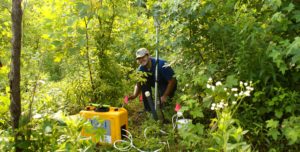
Smithsonian Environmental Research Center intern Chaz Rhodes samples gases in the soil with equipment he helped design and install. It’s part of a new long-term study seeking to untangle what drives changes in the methane budget in forest soils.
by Alison Haigh
When it comes to forests, most people think of soil as a static ingredient in a recipe for growing trees. But talk to any forest ecologist, soil scientist, or biogeochemist, and you’ll get a radically different idea about dirt.
Soils are more like living, breathing ecosystems. Their most abundant residents aren’t plants or insects—they’re microbes. Microbes may be small, but they play a mighty role, especially in the carbon budget: They help make forests the largest carbon sink on the planet. Click to continue »
Posted in Climate Change, Ecology, Interns | Comments Off on How Gassy is the Ground? SERC Intern Burps Baby Forests for Greenhouse Gases
Posted by Kristen Goodhue on September 25th, 2019
Marshes Grow Shorter, Denser Stems Under High Carbon Dioxide, Which Can Help Them Resist Sea Level Rise
by Kristen Minogue
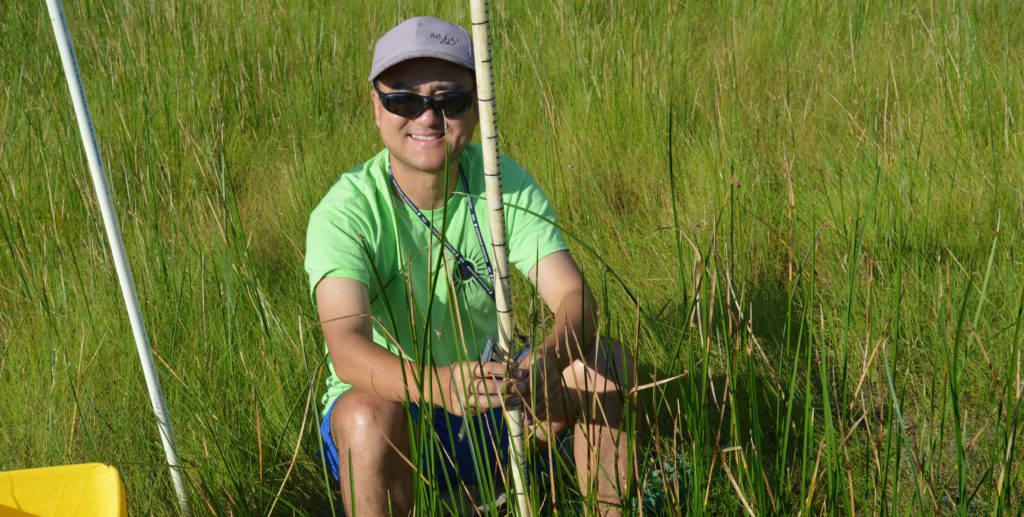
Ecologist Meng Lu measures green blades of sedge in SERC’s Global Change Research Wetland in Maryland. Lu led a discovery that under higher carbon dioxide, sedges like these grow shorter and thinner stems. (Credit: Maria Sharova/SERC)
For most plants, carbon dioxide acts like a steroid: The more they can take in, the bigger they get. But in a new study published Sept. 25, scientists with the Smithsonian discovered something strange happening in marshes. Under higher levels of carbon dioxide, instead of producing bigger stems, marsh plants produced more stems that were noticeably smaller.
“I don’t think anybody expected this,” said Meng Lu, lead author of the new study in the journal Nature Climate Change. For years, scientists had known that carbon dioxide was bulking up the total biomass of marsh plants, so it seemed natural to think individual plants were getting bigger too. “Everyone thought, okay, [plants] increased, biomass increased, so the height, width, all should increase. But that’s not the case in a marsh,” he said.
Click to continue »
Posted in Climate Change, Ecology, Publications, SERC Sites and Scenes | Comments Off on High Carbon Dioxide Can Create “Shrinking Stems” in Marshes
Posted by Kristen Goodhue on August 19th, 2019

Konza Prairie Biological Station in northeast Kansas. (Credit: Kim Komatsu/SERC)
Scientists Discover Species Turnover in Study of More Than 100 Grassland Experiments
by Kristen Minogue
Since the first Homo sapiens emerged in Africa roughly 300,000 years ago, grasslands have sustained humanity and thousands of other species. But today, those grasslands are shifting beneath our feet. Global change—which includes climate change, pollution and other widespread environmental alterations—is transforming the plant species growing in them, and not always in the ways scientists expected, a new study published Monday revealed.
Grasslands make up more than 40 percent of the world’s ice-free land. In addition to providing food for human-raised cattle and sheep, grasslands are home to animals found nowhere else in the wild, such as the bison of North America’s prairies or the zebras and giraffes of the African savannas. Grasslands also can hold up to 30 percent of the world’s carbon, making them critical allies in the fight against climate change. However, changes in the plants that comprise grasslands could put those benefits at risk.
“Is it good rangeland for cattle, or is it good at storing carbon?” said lead author Kim Komatsu, a grassland ecologist at the Smithsonian Environmental Research Center. “It really matters what the identities of the individual species are….You might have a really invaded weedy system that would not be as beneficial for these services that humans depend on.” Click to continue »
Posted in Climate Change, Ecology, Publications | Comments Off on Global Change is Triggering an Identity Switch in Grasslands
Posted by Kristen Goodhue on August 1st, 2019
by Quinn Burkhart
We’ve known for years that many of Earth’s forests are dying out and struggling to replenish their populations. At the Forest Global Earth Observatory, or ForestGEO, scientists are attempting to get to the root of this issue. A global network of research sites and scientists, ForestGEO studies how climate change is affecting tropical and temperate forests globally. Worldwide, ForestGEO examines how forests are changing over time at 67 sites in 27 countries. This totals to about 12,000 species and six million trees. Click to continue »
Posted in Climate Change, Ecology, SERC Sites and Scenes | Comments Off on May The Forest Be With You—SERC’s ForestGEO Census
Posted by Kristen Goodhue on July 22nd, 2019
by Quinn Burkhart
When the word fossil comes to mind, the first thing many people think of are dinosaurs. Of course, dinosaurs are long extinct. Yet, as crazy as it sounds, we can find ourselves walking under the shade of a special fossil that grew in the age of the dinosaurs too. We call this “fossil” a ginkgo tree–an ancient plant giving us a glimpse into the future. Click to continue »
Posted in Publications | Comments Off on The Scientists’ Time Machine—Otherwise Known as Ginkgos
Posted by Kristen Goodhue on July 12th, 2019
by Kristen Minogue
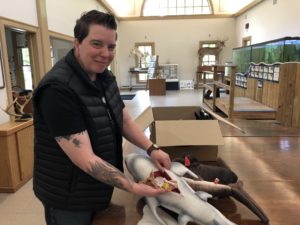
SERC education coordinator Karen McDonald shows the contents in a stuffed shark stomach: bits of bone, a toy turtle and plastic. (Credit: Kristen Minogue/SERC)
Move over, blue crabs. There’s a new predator in the education department. Sharks are making waves as the latest addition to field trips and engineering programs at the Smithsonian Environmental Research Center (SERC).
This spring, SERC added sharks as another station in its “Shoreline Connections” and “Exploring Nature” field trips. The education staff also created a day-long program that lets students think like scientists by planning a shark tagging expedition and designing their own shark tags.
“Most of the students and teachers and even parents don’t realize that there are sharks and rays in the Chesapeake Bay,” said Karen McDonald, director of SERC’s education center. “So this is new to them. And typically the organisms are vilified. So this is a chance for us to show their importance in the ecosystem.” Click to continue »
Posted in Classes and Events, Ecology, Education, Interns, SERC Sites and Scenes | Comments Off on Sharks Debut on SERC Field Trip Menu
Posted by Kristen Goodhue on June 21st, 2019
The Smithsonian Environmental Research Center stays close to its heritage by leasing land to farmers
by Stephanie Fox
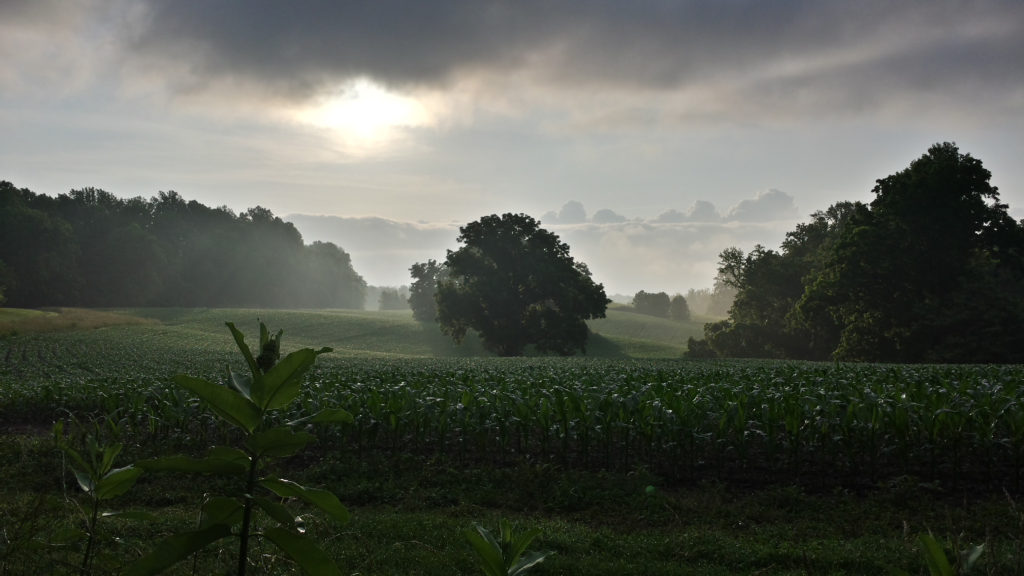
Summer farm fields on the SERC campus (Photo: Nicole Campbell)
Before the Smithsonian Environmental Research Center (SERC) became a bustling scientific center, adorned with research labs and paved roads, it was the Java Dairy Farm, run by an eccentric millionaire named Robert Lee Forrest. In 1962, Forrest passed away, leaving his 368 acres of farmland and other properties along Maryland’s Rhode River to the Smithsonian Institution. Despite some talk of selling the farm to grow the Smithsonian’s endowment, further inspection of the abandoned property revealed an ideal space for field biology and ecology studies.
Over the past 57 years since Forrest’s donation, the property has grown to 2,650 acres, 19 labs and nearly 100 researchers. The majority of the natural terrain is dedicated to studying environmental issues like nutrient pollution and climate change. But SERC also has set aside about 270 acres (three plots of land) for local farmers to lease, as a reminder of the center’s agricultural origins. Click to continue »
Posted in Land Use, SERC Sites and Scenes, Water Quality | Comments Off on Leased Farmland Hearkens Back to Smithsonian’s Agricultural Roots
Posted by Kristen Goodhue on June 18th, 2019
by Quinn Burkhart
Most people need to visit the ocean to get their sea water fix. But beneath their feet, those waters may already be closer than they think. “Saltwater intrusion,” which occurs when the sea level rises and pushes large amounts of saltwater onto the coast, is one of the most prominent—and least talked about—effects of climate change. Its influence on the Chesapeake Bay, one of the lowest regions in the United States, is gaining traction.
Click to continue »
Posted in Climate Change, Ecology, Invasive Species, Land Use, Publications | Comments Off on The Invisible Flood: When We Can’t Tell We’re Drowning
Posted by Kristen Goodhue on June 3rd, 2019
By Stephanie Fox
Each year, thousands of invasive organisms cling to the bottoms of boats, traveling hundreds of miles to distant bays. It’s proven difficult and time consuming for scientists to investigate all the harbors being invaded. So researchers at the Smithsonian Environmental Research Center (SERC) are looking to citizen scientists for help.
Over the last year, volunteers assisted from the comfort of their homes, helping identify invasive species using images online. But this summer, a small group of Invader ID volunteers will get their hands dirty doing experiments of their own in the Chesapeake Bay. Click to continue »
Posted in California, Ecology, Invasive Species, Participatory Science, Volunteers | Comments Off on Invader ID Volunteers Are Deploying Tiles in Chesapeake Bay
Posted by Kristen Goodhue on May 10th, 2019
by Stephanie Fox
Standing on the beach of High Island, Texas, James “Tyler” Bell saw a handful of tiny dots on the horizon and knew he was about to observe something incredible. Within seconds, they grew closer, hovering just above the water before coming ashore.
Many casual observers would have no idea what was happening. But Bell, a staff scientist at the Smithsonian Environmental Research Center’s Microbial Ecology Lab and an avid bird watcher, knew he was witnessing the “Yucatan Express”—a seasonal event in which millions of ruby-throated hummingbirds spend a single evening flying across the Gulf of Mexico from Central America and Mexico to the breezier north.
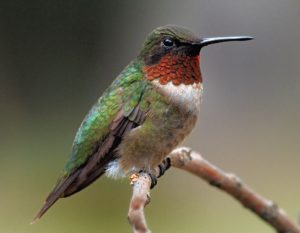
A ruby-throated hummingbird purches on a branch. (Photo: Mickey Estes)
“Millions of individual birds…all arrive in their own time, one by one,” Bell said. The birds often fly in clusters, each group completing the Yucatan Express during different evenings throughout the spring.
For 20 hours the ruby-throated hummingbirds travel more than 500 miles across the water without stopping. Their voyage ends in cooler states that are more suitable for their annual summer nesting.
But the miraculous journey takes its toll on the birds that weigh less than a nickel. Click to continue »
Posted in Ecology | 11 Responses »







